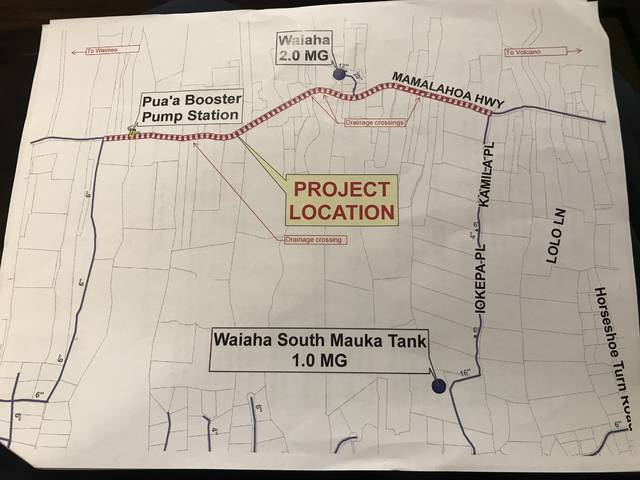KAILUA-KONA —
Hawaii County Department of Water Supply employees at a public meeting in Holualoa Wednesday evening fielded inquiries on a new 16-inch transmission line set to span 5,240 feet of Mamalahoa Highway between Water Pipe Road and Kamila Place.
The primary concerns citizens voiced inside the Kona Imin Center involved impacts to traffic and water disruptions along the line’s path.
“There may be times during the construction schedule that we have to have water shutoffs,” explained Kawika Uyehara, DWS deputy. “It’s inevitable.”
He added the department would use the tools at its disposal, including social media, to inform those subject to disconnection from water services and give them a sense of when it might happen as well as for how long.
Based on the current schedule, customers in West Hawaii won’t have to worry about any service disruptions until at least early March, when construction is set to begin. Work to dig up the road and lay the new waterline will continue into November if the schedule holds.
Workers will be on site somewhere along the roughly mile-long construction zone between either 7 or 8 a.m. and 3:30 p.m. on work days. The exact hours will be released once Isemoto Contracting Co., Ltd., which won the job with a bid of just over $3.5 million, receives its permit from the Hawaii County Department of Public Works.
The DPW permit mandates one lane of traffic must remain clear during construction hours. After construction is completed for the day, the permit requires both lanes be open for travel.
Still, Antu Harvey expressed concern Wednesday over construction exacerbating what is already bumper-to-bumper traffic in the area during the school year. More than 500 students attend Holualoa Elementary, most of whom are dropped off and picked up by car instead of by bus.
Parents come early, she explained, and block off the road. The problem is made worse by motorists hopping up or staying high to avoid afternoon traffic jams on Queen Kaahumanu Highway. Harvey fears speeding, traffic stoppage and unfamiliarity with the area could combine to create dangerous conditions.
She said interested people in Holualoa are already trying to persuade some parents to pursue alternate routes and added that communication and keeping stop times limited on the part of DWS will be key if Holualoa is to avoid becoming a driver’s nightmare during the school year.
There already exists an 8-inch waterline along Mamalahoa Highway, which DWS currently uses for both transmission and distribution to actual customers. Once installed, the 16-inch line will be used exclusively for the purposes of transmitting water between various tanks, allowing DWS to more efficiently move the resource mauka to makai.
The 8-inch line will continue to operate but for distribution purposes only. Kurt Inaba, head of the DWS engineering division, said customers in the region experience lower water pressure when the department runs a higher gallon-per-minute quantity of water through the 8-inch line — a problem creating a new line will solve.
“It’s going to relieve that situation so we should have more steady pressure,” Inaba said.
Installation of the waterline is a Capital Improvement Project and the roughly $3.5 million price tag will be funded by the Hawaii Drinking Water State Revolving Fund.




Mandate the bus